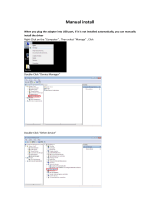
TL-WN851N Wireless N PCI Adapter
2
Chapter 1 Introduction
Thank you for choosing the TL-WN851N Wireless N PCI Adapter!
1.1 Overview of the Product
The adapter is a draft 802.11n client device; it is designed to provide a high-speed and
unrivaled wireless performance for your notebook. With a faster wireless connection, you can
get a better Internet experience, such as downloading, gaming, video streaming and so on.
With the 802.11n technology, higher throughput improvements using MIMO (multiple input,
multiple output antennas), the TL-WN851N’s auto-sensing capability allows high packet transfer
rate of up to 300Mbps for maximum throughput. It has good capability on anti-jamming, and it can
also interoperate with other wireless (802.11b) products. The adapter supports WEP, WPA and
WPA2 encryption to prevent outside intrusion and protect your personal information from being
exposed.
The adapter is easy to install and manage. The Quick Setup Wizard guides you step-by-step
through the installation process; the TP-LINK Wireless N Client Utility helps you create a wireless
connection immediately.
With unmatched wireless performance, reception, and security protection, the TL-WN851N is the
best choice for easily adding or upgrading wireless connectivity to your notebook computer.
1.2 Features
¾ Complies with IEEE802.11n (draft), IEEE802.11g, IEEE802.11b standards
¾ Supports WPA/WPA2 data security, IEEE802.1x authentication, TKIP/AES encryption,
64/128/152-bit WEP encryption
¾ Supports high rate of up to 300Mbps for maximum throughput, supports automatically
adjust to lower speeds due to distance or other operating limitations
¾ Provides 32-bit PCI interface
¾ Supports Ad-Hoc and Infrastructure modes
¾ Good capability on anti-jamming
¾ Supports roaming between access points when configured in Infrastructure mode
¾ Ease to configure and provides monitoring information
¾ Supports Windows 2000, XP, Vista
¾ Built-in two internal antennas which are listed in a format of 2x2 for two receivers and two
transmitters.




















